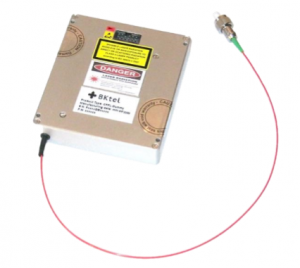BK-FL-Pulsed
Fiber Laser, ns/ps pulsed, 1030-1053nm, up to 500uJ, up to 5W, 400ps to 10ns
POPULAR CONFIGURATIONS:
Picture |
Part Number |
Part Description |
Datasheet |
|
|---|---|---|---|---|

|
HFL-1 |
Pulsed Fiber Laser, 1030-1053nm, Up to 5W |
|
Get Quote |

|
CPFL-1.5t |
Pulsed Fiber Laser, 1530-1560nm, Up to 150mW, |
|
Get Quote |

|
CPFL-1.5at |
Pulsed Fiber Laser, 1540-1560nm, Up to 1W, |
|
Get Quote |

|
CPFL-1.5a |
Pulsed Fiber Laser, 1540-1560nm, Up to 1W, |
|
Get Quote |

|
HFL |
Pulsed Fiber Laser, 1540-1560nm, Up to 4W, |
|
Get Quote |
The FL-P series of pulsed fiber lasers, manufactured to Telcordia standards, is designed for diverse applications with average powers up to 5W at 1μm and 1.5μm, peak powers reaching 25kW, and pulse widths from 400ps to 50ns. Available in both OEM and Turnkey formats, this series delivers flexibility with a wide range of configurations, including pulse monitoring, internal/external triggering, TTL or LVDS input signals, and extended operating temperature options. Its robust, compact design makes it ideal for systems where space and reliability are critical, providing high-quality, customizable laser solutions for the most demanding environments.
Whether it’s the CPFL group with its Telcom-grade compact pulsed lasers for long-range LIDAR and eye-safe operations, or the HFL group, offering high-energy, wavelength-stabilized, Q-switched lasers for applications like LiDAR and 3D scanning, the FL-P series ensures flexibility across a wide spectrum of pulse widths, repetition rates, and center wavelengths. With pulse energies up to 150µJ, pulse repetition rates in the MHz range, and perfect TEM00 beam quality, these lasers are built to meet the exacting demands of modern applications.
Your Perfect Pulsed Fiber Laser Configuration Awaits!
1 & 1.5µm BK-FL-Pulsed Fiber Laser – Configuration Examples
| Center Wavelength (nm) | Power | Pulse Width | Energy | PRR | |
| HFL-1 | 1030 / 1053 / 1064 … 1100 | Up to 5W (25kW peak) | 0.4-10ns | Up to 150µJ | 10-500kHz |
| HFL | 1540…1560 | Up to 4W (5kW peak) | 0.4-50ns | 50µJ | 10-2000kHz |
| CPFL-1.5at | 1540…1560 | Up to 1W (5kW peak) | 0.2-5ns | Up to 80µJ | 10kHz-MHz |
| CPFL-1.5t | 1540…1560 | Up to 150mW (5kW peak) | 0.4-50ns | ≈ 5µJ | 5kHz-MHz |
| CPFL-1.5a | 1540…1560 | Up to 1W (5kW peak) | 0.4-50ns | Up to 80µJ | 10kHz-MHz |
BK-FL-Pulsed Fiber Laser Benefits:
| High Power and Flexibility: |
|
| Wide Pulse Range: |
|
| Compact and Lightweight Design: |
|
| Customizable Configurations: |
|
| Reliable and Robust: |
|
| Perfect Beam Quality: |
|
| Wide Application Range: |
|
Don’t hesitate to ask any questions!
| Wavelength (nm) | |
|---|---|
| Description | Fiber Laser, ns/ps pulsed, 1030-1053nm, up to 500uJ, up to 5W, 400ps to 10ns |
| Type | "Eye Safe", Pulsed Fiber Lasers, Low SWaP, Ruggedized, High Peak Power, Customizable |

 SHIPS TODAY
SHIPS TODAY 



